Modern Arches Vs Ancient Arches
VerifiedAdded on 2023/02/01
|12
|3375
|28
AI Summary
This article discusses the use of arches in architecture and compares the behavior of modern arches and ancient arches. It explores the structure of arches, their evolvement over time, and provides examples of ancient and modern arches. The article also highlights the significance of arches in different architectural styles and their role in supporting heavy loads.
Contribute Materials
Your contribution can guide someone’s learning journey. Share your
documents today.
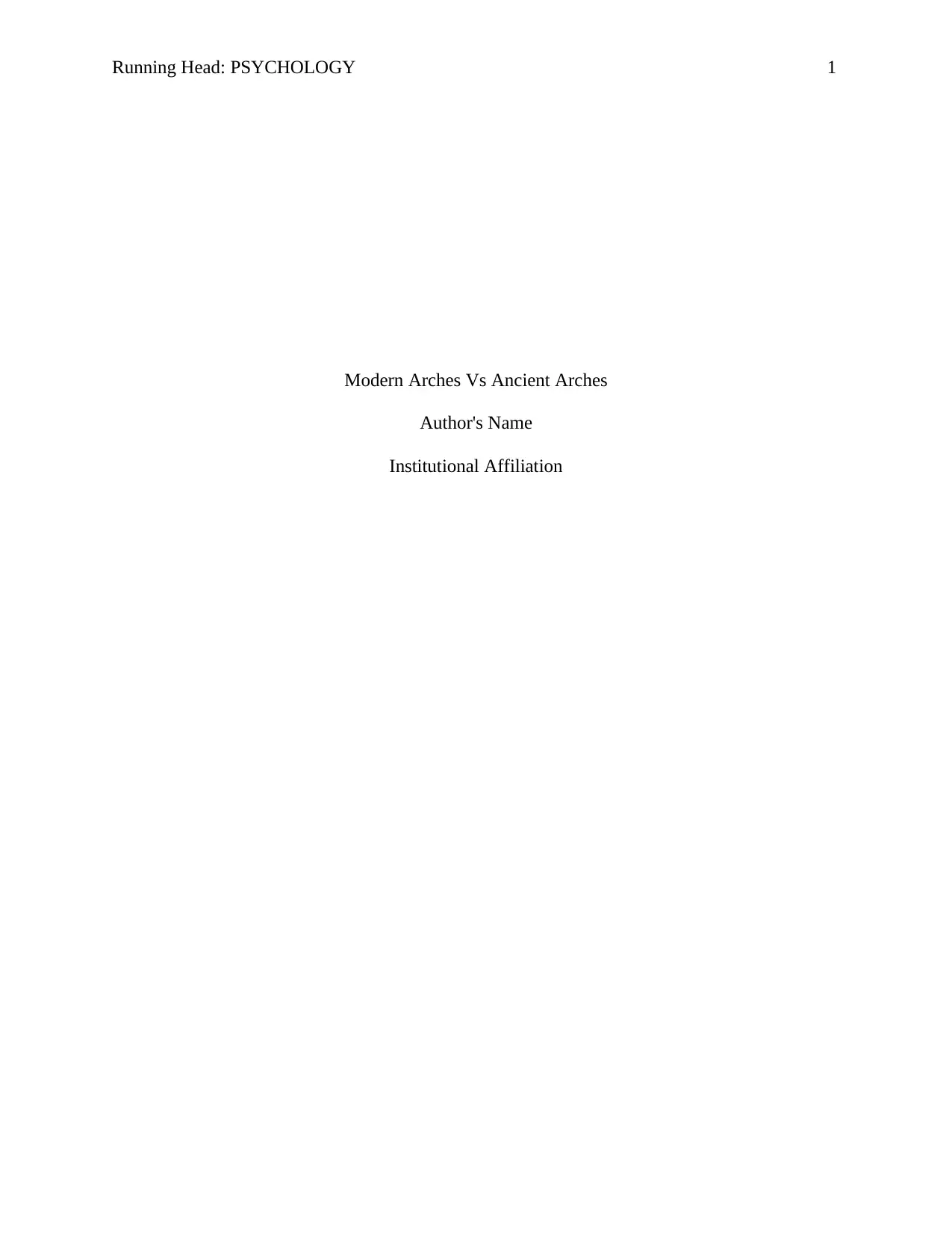
Running Head: PSYCHOLOGY 1
Modern Arches Vs Ancient Arches
Author's Name
Institutional Affiliation
Modern Arches Vs Ancient Arches
Author's Name
Institutional Affiliation
Secure Best Marks with AI Grader
Need help grading? Try our AI Grader for instant feedback on your assignments.
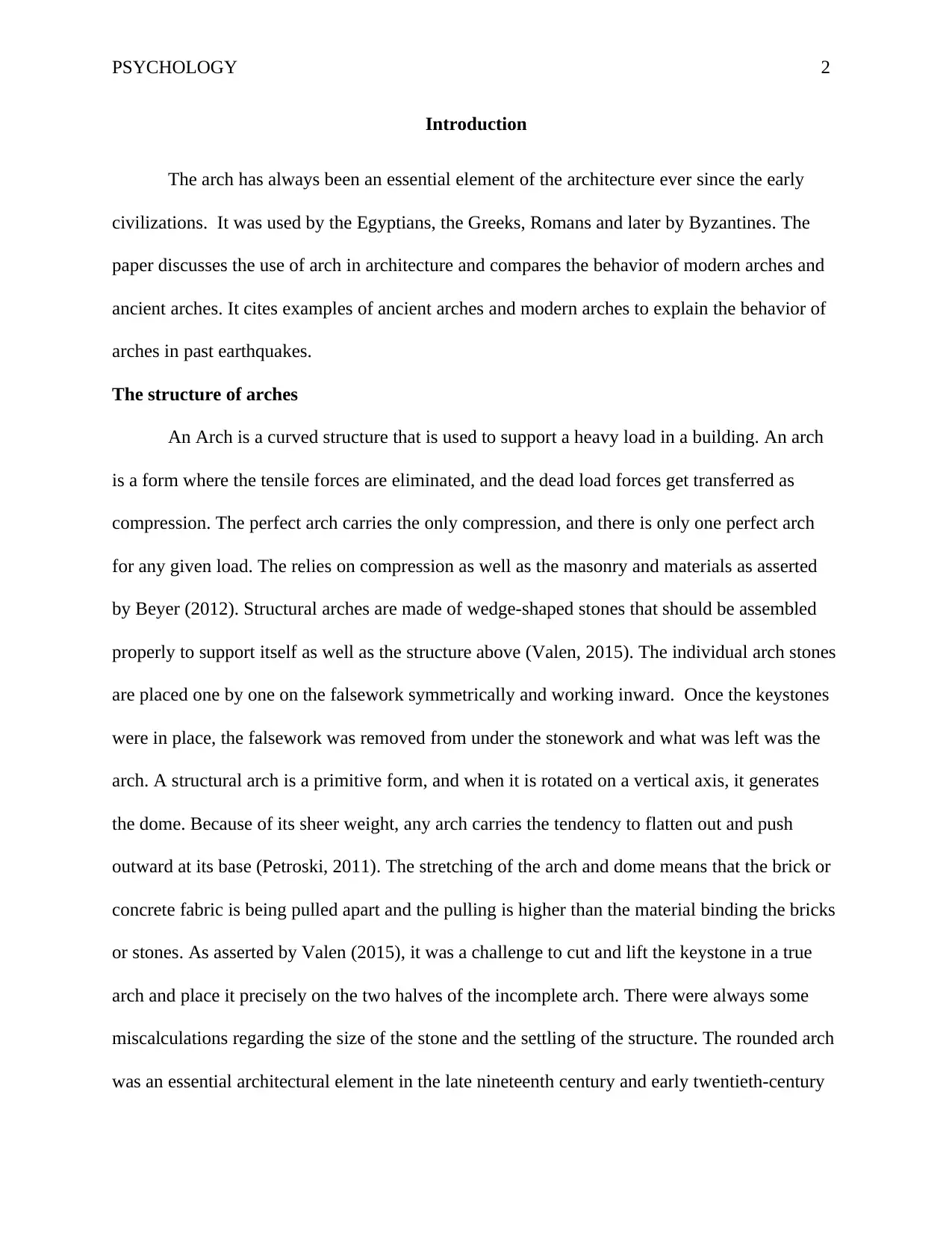
PSYCHOLOGY 2
Introduction
The arch has always been an essential element of the architecture ever since the early
civilizations. It was used by the Egyptians, the Greeks, Romans and later by Byzantines. The
paper discusses the use of arch in architecture and compares the behavior of modern arches and
ancient arches. It cites examples of ancient arches and modern arches to explain the behavior of
arches in past earthquakes.
The structure of arches
An Arch is a curved structure that is used to support a heavy load in a building. An arch
is a form where the tensile forces are eliminated, and the dead load forces get transferred as
compression. The perfect arch carries the only compression, and there is only one perfect arch
for any given load. The relies on compression as well as the masonry and materials as asserted
by Beyer (2012). Structural arches are made of wedge-shaped stones that should be assembled
properly to support itself as well as the structure above (Valen, 2015). The individual arch stones
are placed one by one on the falsework symmetrically and working inward. Once the keystones
were in place, the falsework was removed from under the stonework and what was left was the
arch. A structural arch is a primitive form, and when it is rotated on a vertical axis, it generates
the dome. Because of its sheer weight, any arch carries the tendency to flatten out and push
outward at its base (Petroski, 2011). The stretching of the arch and dome means that the brick or
concrete fabric is being pulled apart and the pulling is higher than the material binding the bricks
or stones. As asserted by Valen (2015), it was a challenge to cut and lift the keystone in a true
arch and place it precisely on the two halves of the incomplete arch. There were always some
miscalculations regarding the size of the stone and the settling of the structure. The rounded arch
was an essential architectural element in the late nineteenth century and early twentieth-century
Introduction
The arch has always been an essential element of the architecture ever since the early
civilizations. It was used by the Egyptians, the Greeks, Romans and later by Byzantines. The
paper discusses the use of arch in architecture and compares the behavior of modern arches and
ancient arches. It cites examples of ancient arches and modern arches to explain the behavior of
arches in past earthquakes.
The structure of arches
An Arch is a curved structure that is used to support a heavy load in a building. An arch
is a form where the tensile forces are eliminated, and the dead load forces get transferred as
compression. The perfect arch carries the only compression, and there is only one perfect arch
for any given load. The relies on compression as well as the masonry and materials as asserted
by Beyer (2012). Structural arches are made of wedge-shaped stones that should be assembled
properly to support itself as well as the structure above (Valen, 2015). The individual arch stones
are placed one by one on the falsework symmetrically and working inward. Once the keystones
were in place, the falsework was removed from under the stonework and what was left was the
arch. A structural arch is a primitive form, and when it is rotated on a vertical axis, it generates
the dome. Because of its sheer weight, any arch carries the tendency to flatten out and push
outward at its base (Petroski, 2011). The stretching of the arch and dome means that the brick or
concrete fabric is being pulled apart and the pulling is higher than the material binding the bricks
or stones. As asserted by Valen (2015), it was a challenge to cut and lift the keystone in a true
arch and place it precisely on the two halves of the incomplete arch. There were always some
miscalculations regarding the size of the stone and the settling of the structure. The rounded arch
was an essential architectural element in the late nineteenth century and early twentieth-century
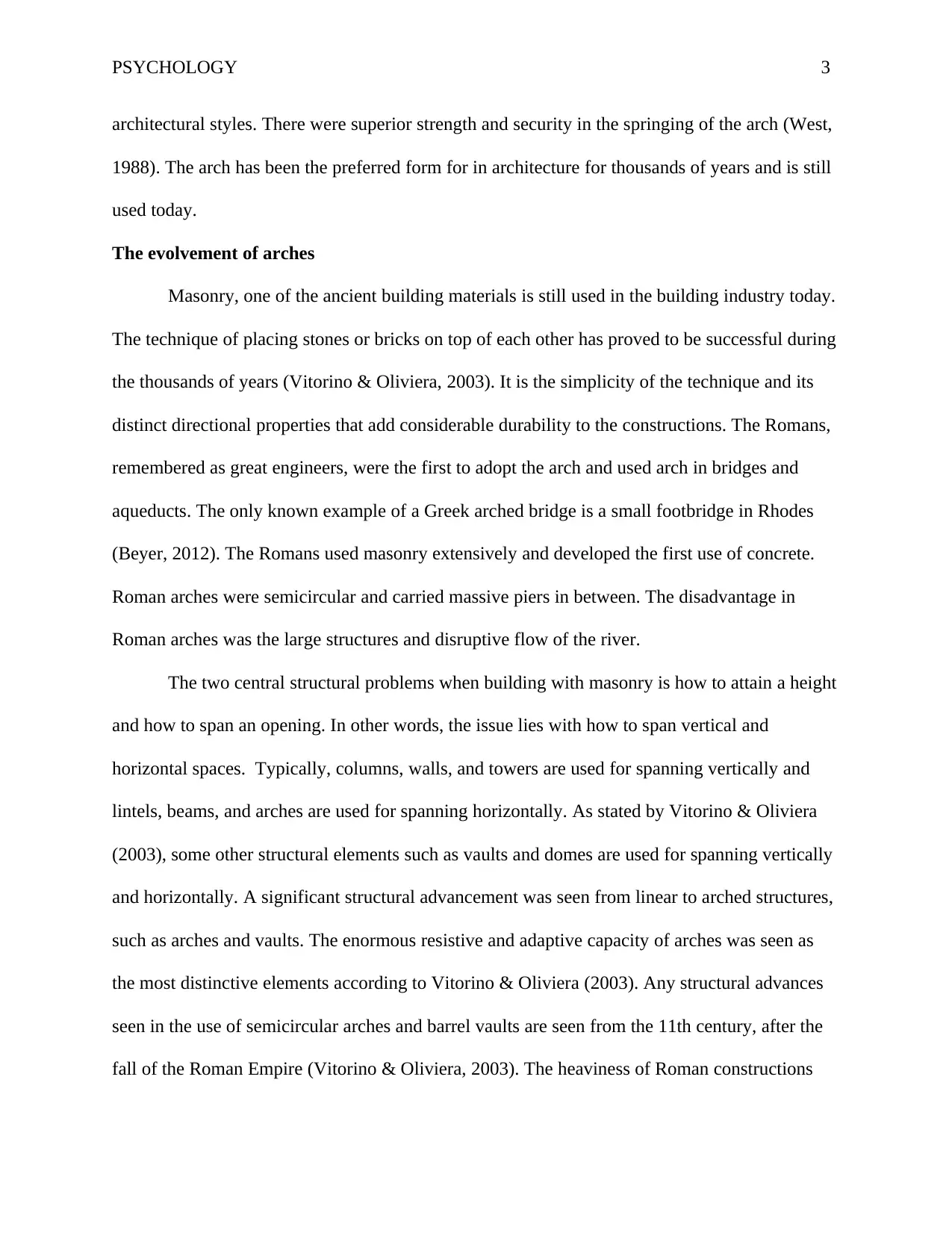
PSYCHOLOGY 3
architectural styles. There were superior strength and security in the springing of the arch (West,
1988). The arch has been the preferred form for in architecture for thousands of years and is still
used today.
The evolvement of arches
Masonry, one of the ancient building materials is still used in the building industry today.
The technique of placing stones or bricks on top of each other has proved to be successful during
the thousands of years (Vitorino & Oliviera, 2003). It is the simplicity of the technique and its
distinct directional properties that add considerable durability to the constructions. The Romans,
remembered as great engineers, were the first to adopt the arch and used arch in bridges and
aqueducts. The only known example of a Greek arched bridge is a small footbridge in Rhodes
(Beyer, 2012). The Romans used masonry extensively and developed the first use of concrete.
Roman arches were semicircular and carried massive piers in between. The disadvantage in
Roman arches was the large structures and disruptive flow of the river.
The two central structural problems when building with masonry is how to attain a height
and how to span an opening. In other words, the issue lies with how to span vertical and
horizontal spaces. Typically, columns, walls, and towers are used for spanning vertically and
lintels, beams, and arches are used for spanning horizontally. As stated by Vitorino & Oliviera
(2003), some other structural elements such as vaults and domes are used for spanning vertically
and horizontally. A significant structural advancement was seen from linear to arched structures,
such as arches and vaults. The enormous resistive and adaptive capacity of arches was seen as
the most distinctive elements according to Vitorino & Oliviera (2003). Any structural advances
seen in the use of semicircular arches and barrel vaults are seen from the 11th century, after the
fall of the Roman Empire (Vitorino & Oliviera, 2003). The heaviness of Roman constructions
architectural styles. There were superior strength and security in the springing of the arch (West,
1988). The arch has been the preferred form for in architecture for thousands of years and is still
used today.
The evolvement of arches
Masonry, one of the ancient building materials is still used in the building industry today.
The technique of placing stones or bricks on top of each other has proved to be successful during
the thousands of years (Vitorino & Oliviera, 2003). It is the simplicity of the technique and its
distinct directional properties that add considerable durability to the constructions. The Romans,
remembered as great engineers, were the first to adopt the arch and used arch in bridges and
aqueducts. The only known example of a Greek arched bridge is a small footbridge in Rhodes
(Beyer, 2012). The Romans used masonry extensively and developed the first use of concrete.
Roman arches were semicircular and carried massive piers in between. The disadvantage in
Roman arches was the large structures and disruptive flow of the river.
The two central structural problems when building with masonry is how to attain a height
and how to span an opening. In other words, the issue lies with how to span vertical and
horizontal spaces. Typically, columns, walls, and towers are used for spanning vertically and
lintels, beams, and arches are used for spanning horizontally. As stated by Vitorino & Oliviera
(2003), some other structural elements such as vaults and domes are used for spanning vertically
and horizontally. A significant structural advancement was seen from linear to arched structures,
such as arches and vaults. The enormous resistive and adaptive capacity of arches was seen as
the most distinctive elements according to Vitorino & Oliviera (2003). Any structural advances
seen in the use of semicircular arches and barrel vaults are seen from the 11th century, after the
fall of the Roman Empire (Vitorino & Oliviera, 2003). The heaviness of Roman constructions
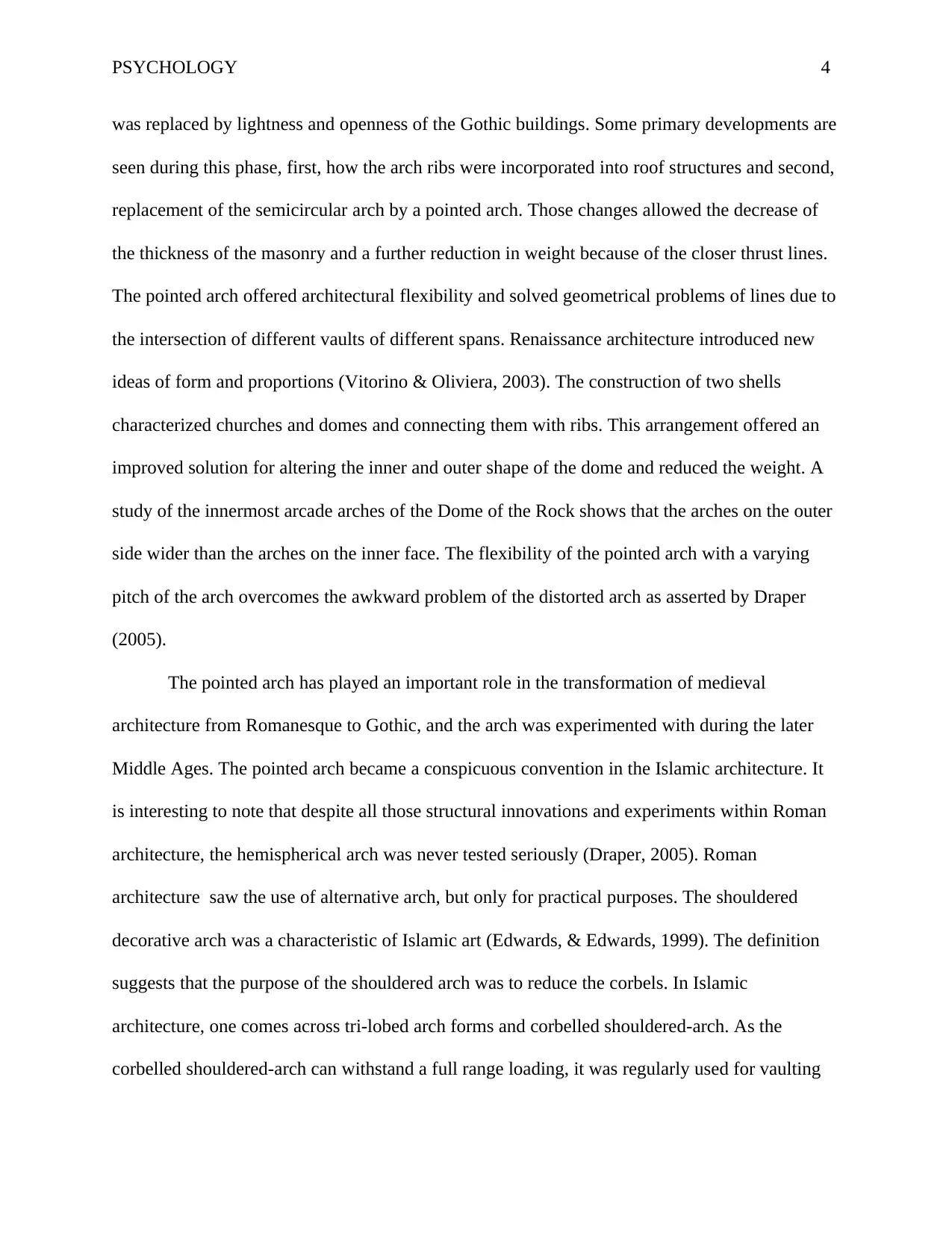
PSYCHOLOGY 4
was replaced by lightness and openness of the Gothic buildings. Some primary developments are
seen during this phase, first, how the arch ribs were incorporated into roof structures and second,
replacement of the semicircular arch by a pointed arch. Those changes allowed the decrease of
the thickness of the masonry and a further reduction in weight because of the closer thrust lines.
The pointed arch offered architectural flexibility and solved geometrical problems of lines due to
the intersection of different vaults of different spans. Renaissance architecture introduced new
ideas of form and proportions (Vitorino & Oliviera, 2003). The construction of two shells
characterized churches and domes and connecting them with ribs. This arrangement offered an
improved solution for altering the inner and outer shape of the dome and reduced the weight. A
study of the innermost arcade arches of the Dome of the Rock shows that the arches on the outer
side wider than the arches on the inner face. The flexibility of the pointed arch with a varying
pitch of the arch overcomes the awkward problem of the distorted arch as asserted by Draper
(2005).
The pointed arch has played an important role in the transformation of medieval
architecture from Romanesque to Gothic, and the arch was experimented with during the later
Middle Ages. The pointed arch became a conspicuous convention in the Islamic architecture. It
is interesting to note that despite all those structural innovations and experiments within Roman
architecture, the hemispherical arch was never tested seriously (Draper, 2005). Roman
architecture saw the use of alternative arch, but only for practical purposes. The shouldered
decorative arch was a characteristic of Islamic art (Edwards, & Edwards, 1999). The definition
suggests that the purpose of the shouldered arch was to reduce the corbels. In Islamic
architecture, one comes across tri-lobed arch forms and corbelled shouldered-arch. As the
corbelled shouldered-arch can withstand a full range loading, it was regularly used for vaulting
was replaced by lightness and openness of the Gothic buildings. Some primary developments are
seen during this phase, first, how the arch ribs were incorporated into roof structures and second,
replacement of the semicircular arch by a pointed arch. Those changes allowed the decrease of
the thickness of the masonry and a further reduction in weight because of the closer thrust lines.
The pointed arch offered architectural flexibility and solved geometrical problems of lines due to
the intersection of different vaults of different spans. Renaissance architecture introduced new
ideas of form and proportions (Vitorino & Oliviera, 2003). The construction of two shells
characterized churches and domes and connecting them with ribs. This arrangement offered an
improved solution for altering the inner and outer shape of the dome and reduced the weight. A
study of the innermost arcade arches of the Dome of the Rock shows that the arches on the outer
side wider than the arches on the inner face. The flexibility of the pointed arch with a varying
pitch of the arch overcomes the awkward problem of the distorted arch as asserted by Draper
(2005).
The pointed arch has played an important role in the transformation of medieval
architecture from Romanesque to Gothic, and the arch was experimented with during the later
Middle Ages. The pointed arch became a conspicuous convention in the Islamic architecture. It
is interesting to note that despite all those structural innovations and experiments within Roman
architecture, the hemispherical arch was never tested seriously (Draper, 2005). Roman
architecture saw the use of alternative arch, but only for practical purposes. The shouldered
decorative arch was a characteristic of Islamic art (Edwards, & Edwards, 1999). The definition
suggests that the purpose of the shouldered arch was to reduce the corbels. In Islamic
architecture, one comes across tri-lobed arch forms and corbelled shouldered-arch. As the
corbelled shouldered-arch can withstand a full range loading, it was regularly used for vaulting
Secure Best Marks with AI Grader
Need help grading? Try our AI Grader for instant feedback on your assignments.
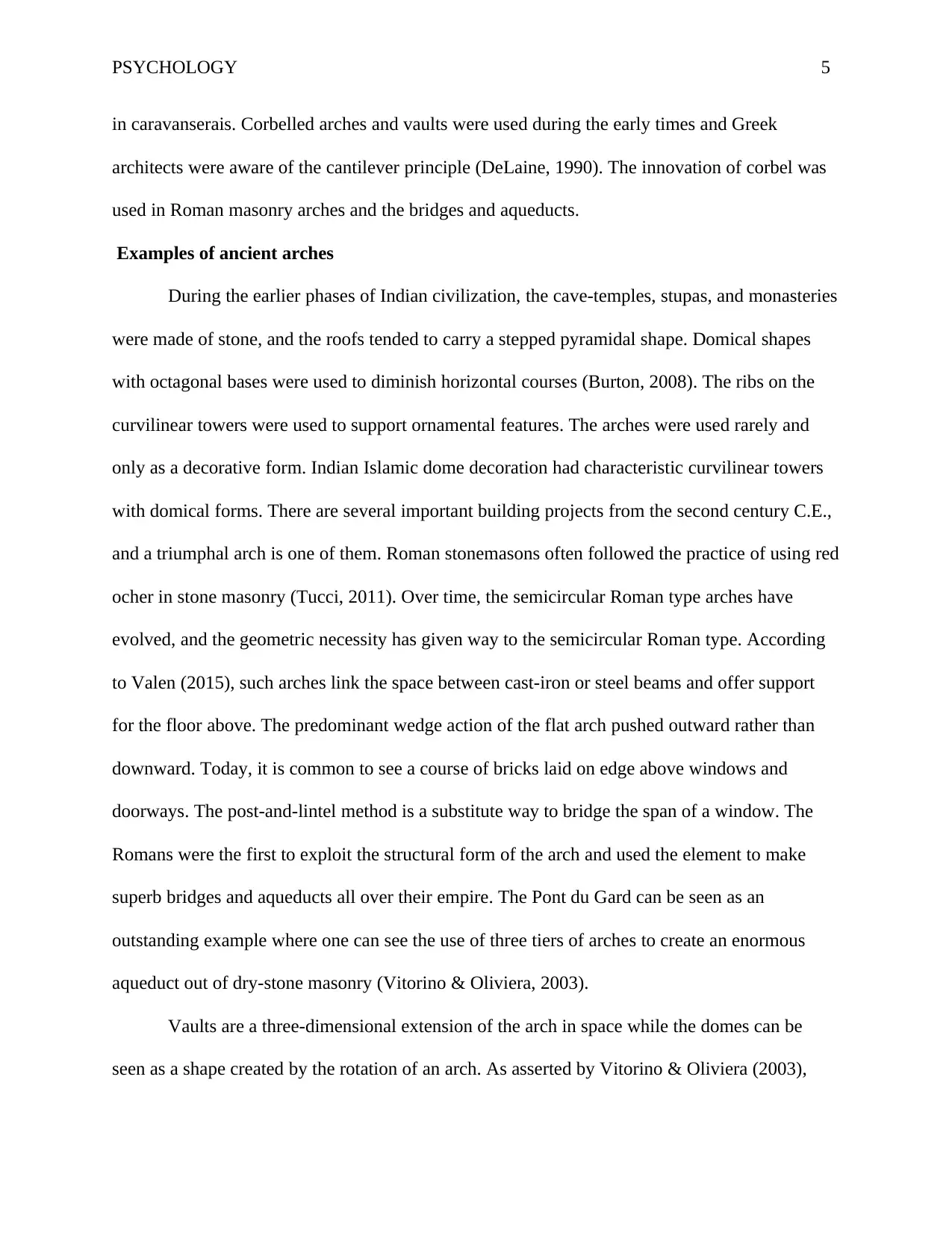
PSYCHOLOGY 5
in caravanserais. Corbelled arches and vaults were used during the early times and Greek
architects were aware of the cantilever principle (DeLaine, 1990). The innovation of corbel was
used in Roman masonry arches and the bridges and aqueducts.
Examples of ancient arches
During the earlier phases of Indian civilization, the cave-temples, stupas, and monasteries
were made of stone, and the roofs tended to carry a stepped pyramidal shape. Domical shapes
with octagonal bases were used to diminish horizontal courses (Burton, 2008). The ribs on the
curvilinear towers were used to support ornamental features. The arches were used rarely and
only as a decorative form. Indian Islamic dome decoration had characteristic curvilinear towers
with domical forms. There are several important building projects from the second century C.E.,
and a triumphal arch is one of them. Roman stonemasons often followed the practice of using red
ocher in stone masonry (Tucci, 2011). Over time, the semicircular Roman type arches have
evolved, and the geometric necessity has given way to the semicircular Roman type. According
to Valen (2015), such arches link the space between cast-iron or steel beams and offer support
for the floor above. The predominant wedge action of the flat arch pushed outward rather than
downward. Today, it is common to see a course of bricks laid on edge above windows and
doorways. The post-and-lintel method is a substitute way to bridge the span of a window. The
Romans were the first to exploit the structural form of the arch and used the element to make
superb bridges and aqueducts all over their empire. The Pont du Gard can be seen as an
outstanding example where one can see the use of three tiers of arches to create an enormous
aqueduct out of dry-stone masonry (Vitorino & Oliviera, 2003).
Vaults are a three-dimensional extension of the arch in space while the domes can be
seen as a shape created by the rotation of an arch. As asserted by Vitorino & Oliviera (2003),
in caravanserais. Corbelled arches and vaults were used during the early times and Greek
architects were aware of the cantilever principle (DeLaine, 1990). The innovation of corbel was
used in Roman masonry arches and the bridges and aqueducts.
Examples of ancient arches
During the earlier phases of Indian civilization, the cave-temples, stupas, and monasteries
were made of stone, and the roofs tended to carry a stepped pyramidal shape. Domical shapes
with octagonal bases were used to diminish horizontal courses (Burton, 2008). The ribs on the
curvilinear towers were used to support ornamental features. The arches were used rarely and
only as a decorative form. Indian Islamic dome decoration had characteristic curvilinear towers
with domical forms. There are several important building projects from the second century C.E.,
and a triumphal arch is one of them. Roman stonemasons often followed the practice of using red
ocher in stone masonry (Tucci, 2011). Over time, the semicircular Roman type arches have
evolved, and the geometric necessity has given way to the semicircular Roman type. According
to Valen (2015), such arches link the space between cast-iron or steel beams and offer support
for the floor above. The predominant wedge action of the flat arch pushed outward rather than
downward. Today, it is common to see a course of bricks laid on edge above windows and
doorways. The post-and-lintel method is a substitute way to bridge the span of a window. The
Romans were the first to exploit the structural form of the arch and used the element to make
superb bridges and aqueducts all over their empire. The Pont du Gard can be seen as an
outstanding example where one can see the use of three tiers of arches to create an enormous
aqueduct out of dry-stone masonry (Vitorino & Oliviera, 2003).
Vaults are a three-dimensional extension of the arch in space while the domes can be
seen as a shape created by the rotation of an arch. As asserted by Vitorino & Oliviera (2003),

PSYCHOLOGY 6
barrel vaults and domes allowed the building of large-span and durable roofs that were fire-
resistant. Hagia Sophia in Istanbul offers an excellent example where one can see the intricate
arrangements of vaults and domes that help to make a heavy construction as well as elegant
geometry. The use of pillaged material from Hindu and Jain temples can be seen in the earliest
phase of Muslim building in Delhi. The arch appears for the first time in the Masjid Quwwat al-
Islam at Delhi (Burton, 2008). However, these arches are not voussoired but corbelled out.
Although the masonry has well-dressed surfaces, there is no true arch or dome. Iletmish’s square
tomb is structured by simple corbelled squinch arches across each corner. The tomb of the
emperor Balban shows the appearance of the true voussoired arch (Burton, 2008). Tughluq
period buildings show a polychromatic work in red sandstone and white marble and exhibit the
façade arches and planes.
The three-story Saint-Étienne church at Vignory shows a horizontally projecting impost
that separates the arch above from each column and coursed pier (Armi, 2015). Vaults were
virtually unknown in these churches. The arrangement of capitals, supports, imposts, wooden
beams which were typical of many early French churches, were seen as separate parts. The
vaults often appear as ornamental and structural elements. Catalonia masons experimented with
vaults and arches and presented a range of uncommon supports to expand the size and context of
vaults. For example, Santa María at Ripoll and Sant Vicençt show large-sized barrel vaults in the
choir (Armi, 2015). Ripoll stone apses reflect how the pressure from the half-dome protects the
transverse arches from the weightiness of the roof and beams. As asserted by Burton (2008), the
earliest buildings at Tribeni and Chota Pandua show the use of pillars and shallow corbelled
domes. Some builders were still experimenting with the arch as a structural device as one can see
barrel vaults and domes allowed the building of large-span and durable roofs that were fire-
resistant. Hagia Sophia in Istanbul offers an excellent example where one can see the intricate
arrangements of vaults and domes that help to make a heavy construction as well as elegant
geometry. The use of pillaged material from Hindu and Jain temples can be seen in the earliest
phase of Muslim building in Delhi. The arch appears for the first time in the Masjid Quwwat al-
Islam at Delhi (Burton, 2008). However, these arches are not voussoired but corbelled out.
Although the masonry has well-dressed surfaces, there is no true arch or dome. Iletmish’s square
tomb is structured by simple corbelled squinch arches across each corner. The tomb of the
emperor Balban shows the appearance of the true voussoired arch (Burton, 2008). Tughluq
period buildings show a polychromatic work in red sandstone and white marble and exhibit the
façade arches and planes.
The three-story Saint-Étienne church at Vignory shows a horizontally projecting impost
that separates the arch above from each column and coursed pier (Armi, 2015). Vaults were
virtually unknown in these churches. The arrangement of capitals, supports, imposts, wooden
beams which were typical of many early French churches, were seen as separate parts. The
vaults often appear as ornamental and structural elements. Catalonia masons experimented with
vaults and arches and presented a range of uncommon supports to expand the size and context of
vaults. For example, Santa María at Ripoll and Sant Vicençt show large-sized barrel vaults in the
choir (Armi, 2015). Ripoll stone apses reflect how the pressure from the half-dome protects the
transverse arches from the weightiness of the roof and beams. As asserted by Burton (2008), the
earliest buildings at Tribeni and Chota Pandua show the use of pillars and shallow corbelled
domes. Some builders were still experimenting with the arch as a structural device as one can see
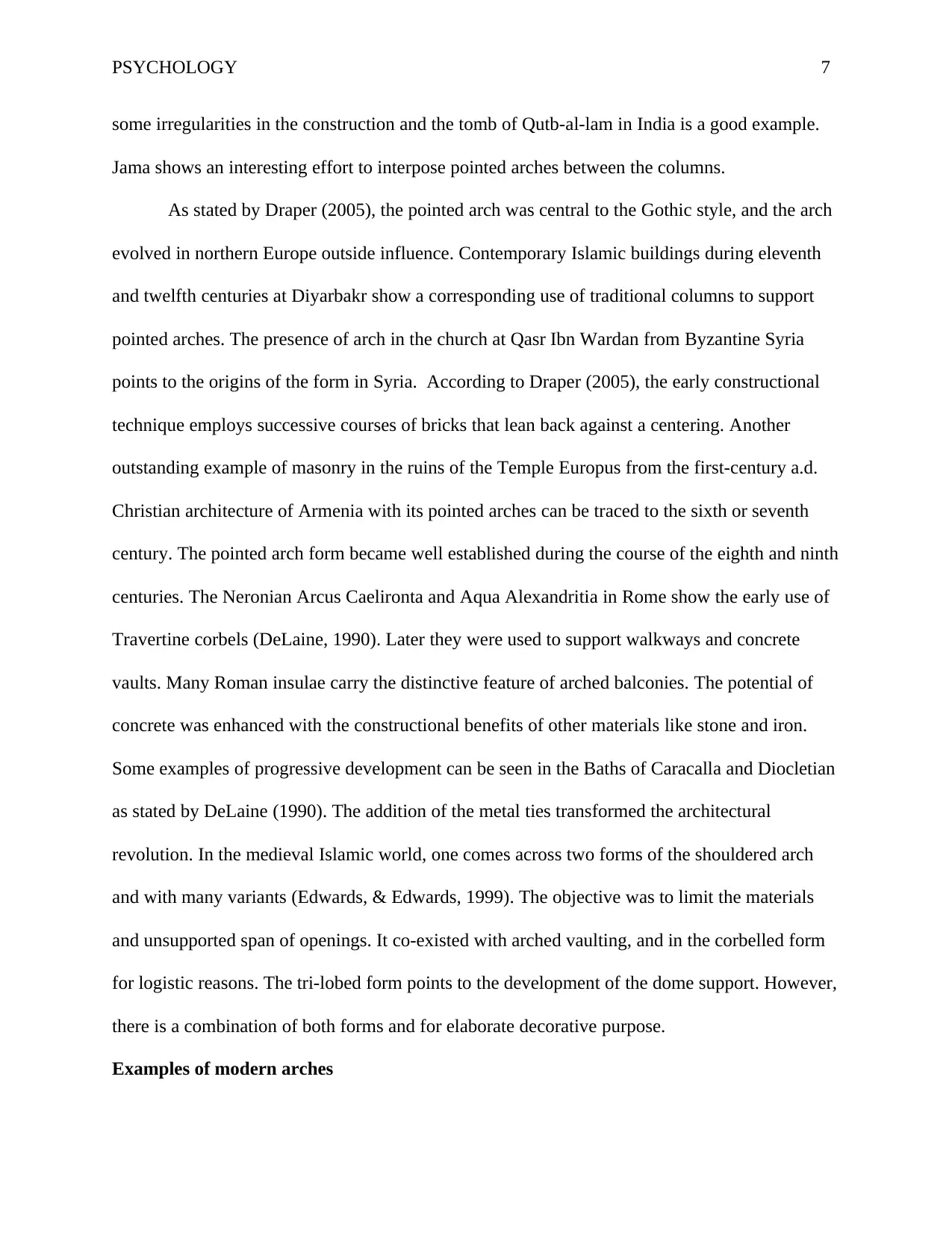
PSYCHOLOGY 7
some irregularities in the construction and the tomb of Qutb-al-lam in India is a good example.
Jama shows an interesting effort to interpose pointed arches between the columns.
As stated by Draper (2005), the pointed arch was central to the Gothic style, and the arch
evolved in northern Europe outside influence. Contemporary Islamic buildings during eleventh
and twelfth centuries at Diyarbakr show a corresponding use of traditional columns to support
pointed arches. The presence of arch in the church at Qasr Ibn Wardan from Byzantine Syria
points to the origins of the form in Syria. According to Draper (2005), the early constructional
technique employs successive courses of bricks that lean back against a centering. Another
outstanding example of masonry in the ruins of the Temple Europus from the first-century a.d.
Christian architecture of Armenia with its pointed arches can be traced to the sixth or seventh
century. The pointed arch form became well established during the course of the eighth and ninth
centuries. The Neronian Arcus Caelironta and Aqua Alexandritia in Rome show the early use of
Travertine corbels (DeLaine, 1990). Later they were used to support walkways and concrete
vaults. Many Roman insulae carry the distinctive feature of arched balconies. The potential of
concrete was enhanced with the constructional benefits of other materials like stone and iron.
Some examples of progressive development can be seen in the Baths of Caracalla and Diocletian
as stated by DeLaine (1990). The addition of the metal ties transformed the architectural
revolution. In the medieval Islamic world, one comes across two forms of the shouldered arch
and with many variants (Edwards, & Edwards, 1999). The objective was to limit the materials
and unsupported span of openings. It co-existed with arched vaulting, and in the corbelled form
for logistic reasons. The tri-lobed form points to the development of the dome support. However,
there is a combination of both forms and for elaborate decorative purpose.
Examples of modern arches
some irregularities in the construction and the tomb of Qutb-al-lam in India is a good example.
Jama shows an interesting effort to interpose pointed arches between the columns.
As stated by Draper (2005), the pointed arch was central to the Gothic style, and the arch
evolved in northern Europe outside influence. Contemporary Islamic buildings during eleventh
and twelfth centuries at Diyarbakr show a corresponding use of traditional columns to support
pointed arches. The presence of arch in the church at Qasr Ibn Wardan from Byzantine Syria
points to the origins of the form in Syria. According to Draper (2005), the early constructional
technique employs successive courses of bricks that lean back against a centering. Another
outstanding example of masonry in the ruins of the Temple Europus from the first-century a.d.
Christian architecture of Armenia with its pointed arches can be traced to the sixth or seventh
century. The pointed arch form became well established during the course of the eighth and ninth
centuries. The Neronian Arcus Caelironta and Aqua Alexandritia in Rome show the early use of
Travertine corbels (DeLaine, 1990). Later they were used to support walkways and concrete
vaults. Many Roman insulae carry the distinctive feature of arched balconies. The potential of
concrete was enhanced with the constructional benefits of other materials like stone and iron.
Some examples of progressive development can be seen in the Baths of Caracalla and Diocletian
as stated by DeLaine (1990). The addition of the metal ties transformed the architectural
revolution. In the medieval Islamic world, one comes across two forms of the shouldered arch
and with many variants (Edwards, & Edwards, 1999). The objective was to limit the materials
and unsupported span of openings. It co-existed with arched vaulting, and in the corbelled form
for logistic reasons. The tri-lobed form points to the development of the dome support. However,
there is a combination of both forms and for elaborate decorative purpose.
Examples of modern arches
Paraphrase This Document
Need a fresh take? Get an instant paraphrase of this document with our AI Paraphraser
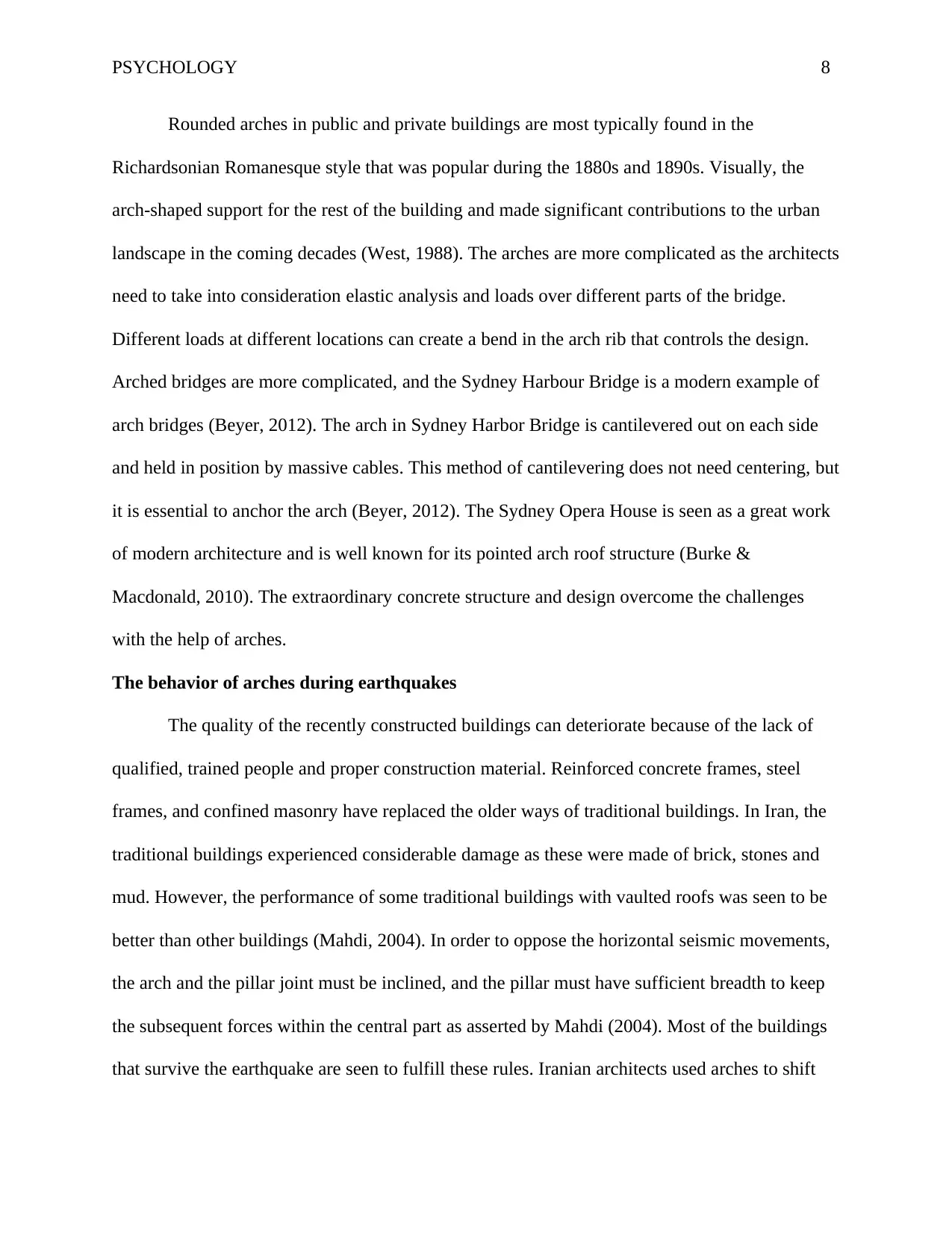
PSYCHOLOGY 8
Rounded arches in public and private buildings are most typically found in the
Richardsonian Romanesque style that was popular during the 1880s and 1890s. Visually, the
arch-shaped support for the rest of the building and made significant contributions to the urban
landscape in the coming decades (West, 1988). The arches are more complicated as the architects
need to take into consideration elastic analysis and loads over different parts of the bridge.
Different loads at different locations can create a bend in the arch rib that controls the design.
Arched bridges are more complicated, and the Sydney Harbour Bridge is a modern example of
arch bridges (Beyer, 2012). The arch in Sydney Harbor Bridge is cantilevered out on each side
and held in position by massive cables. This method of cantilevering does not need centering, but
it is essential to anchor the arch (Beyer, 2012). The Sydney Opera House is seen as a great work
of modern architecture and is well known for its pointed arch roof structure (Burke &
Macdonald, 2010). The extraordinary concrete structure and design overcome the challenges
with the help of arches.
The behavior of arches during earthquakes
The quality of the recently constructed buildings can deteriorate because of the lack of
qualified, trained people and proper construction material. Reinforced concrete frames, steel
frames, and confined masonry have replaced the older ways of traditional buildings. In Iran, the
traditional buildings experienced considerable damage as these were made of brick, stones and
mud. However, the performance of some traditional buildings with vaulted roofs was seen to be
better than other buildings (Mahdi, 2004). In order to oppose the horizontal seismic movements,
the arch and the pillar joint must be inclined, and the pillar must have sufficient breadth to keep
the subsequent forces within the central part as asserted by Mahdi (2004). Most of the buildings
that survive the earthquake are seen to fulfill these rules. Iranian architects used arches to shift
Rounded arches in public and private buildings are most typically found in the
Richardsonian Romanesque style that was popular during the 1880s and 1890s. Visually, the
arch-shaped support for the rest of the building and made significant contributions to the urban
landscape in the coming decades (West, 1988). The arches are more complicated as the architects
need to take into consideration elastic analysis and loads over different parts of the bridge.
Different loads at different locations can create a bend in the arch rib that controls the design.
Arched bridges are more complicated, and the Sydney Harbour Bridge is a modern example of
arch bridges (Beyer, 2012). The arch in Sydney Harbor Bridge is cantilevered out on each side
and held in position by massive cables. This method of cantilevering does not need centering, but
it is essential to anchor the arch (Beyer, 2012). The Sydney Opera House is seen as a great work
of modern architecture and is well known for its pointed arch roof structure (Burke &
Macdonald, 2010). The extraordinary concrete structure and design overcome the challenges
with the help of arches.
The behavior of arches during earthquakes
The quality of the recently constructed buildings can deteriorate because of the lack of
qualified, trained people and proper construction material. Reinforced concrete frames, steel
frames, and confined masonry have replaced the older ways of traditional buildings. In Iran, the
traditional buildings experienced considerable damage as these were made of brick, stones and
mud. However, the performance of some traditional buildings with vaulted roofs was seen to be
better than other buildings (Mahdi, 2004). In order to oppose the horizontal seismic movements,
the arch and the pillar joint must be inclined, and the pillar must have sufficient breadth to keep
the subsequent forces within the central part as asserted by Mahdi (2004). Most of the buildings
that survive the earthquake are seen to fulfill these rules. Iranian architects used arches to shift
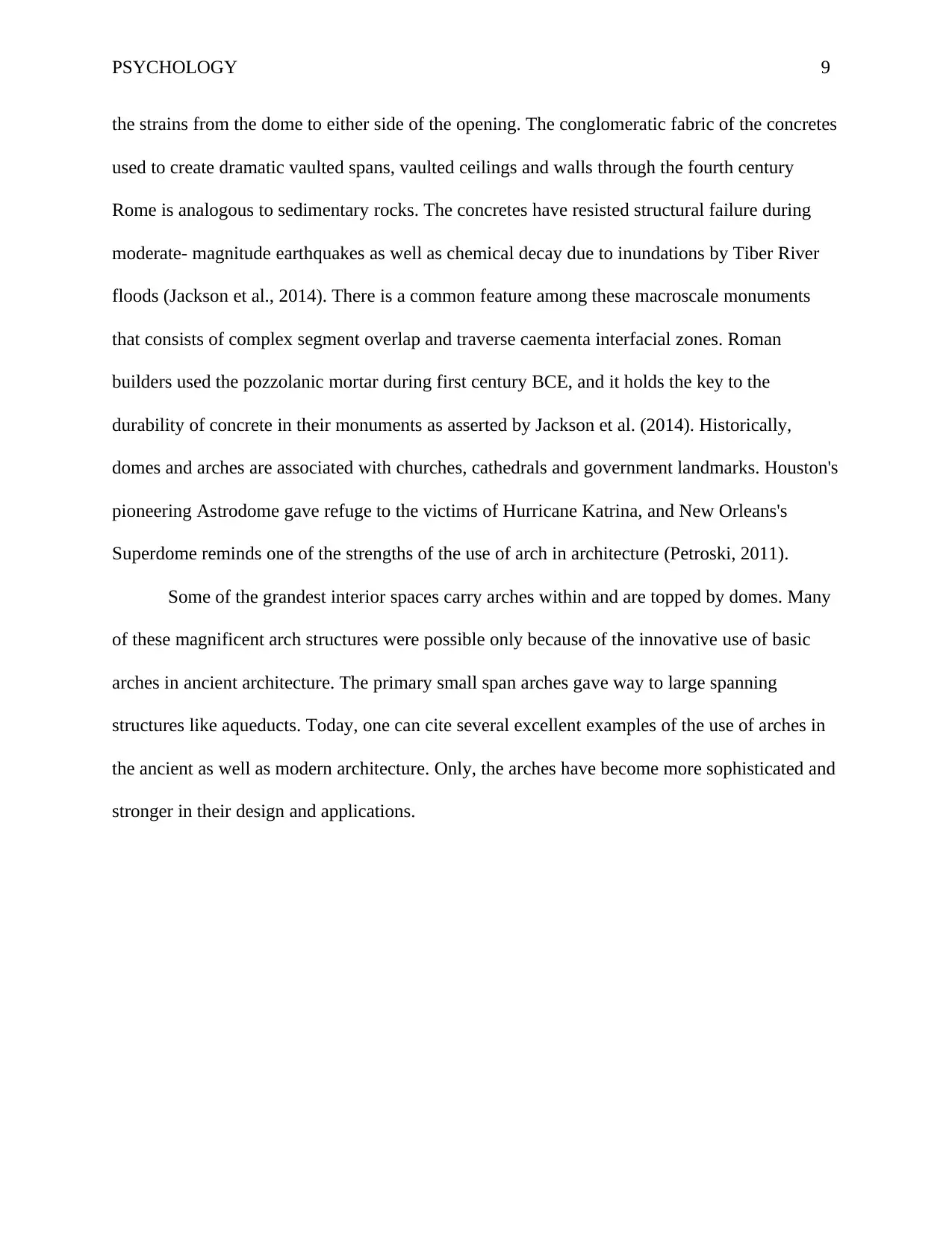
PSYCHOLOGY 9
the strains from the dome to either side of the opening. The conglomeratic fabric of the concretes
used to create dramatic vaulted spans, vaulted ceilings and walls through the fourth century
Rome is analogous to sedimentary rocks. The concretes have resisted structural failure during
moderate- magnitude earthquakes as well as chemical decay due to inundations by Tiber River
floods (Jackson et al., 2014). There is a common feature among these macroscale monuments
that consists of complex segment overlap and traverse caementa interfacial zones. Roman
builders used the pozzolanic mortar during first century BCE, and it holds the key to the
durability of concrete in their monuments as asserted by Jackson et al. (2014). Historically,
domes and arches are associated with churches, cathedrals and government landmarks. Houston's
pioneering Astrodome gave refuge to the victims of Hurricane Katrina, and New Orleans's
Superdome reminds one of the strengths of the use of arch in architecture (Petroski, 2011).
Some of the grandest interior spaces carry arches within and are topped by domes. Many
of these magnificent arch structures were possible only because of the innovative use of basic
arches in ancient architecture. The primary small span arches gave way to large spanning
structures like aqueducts. Today, one can cite several excellent examples of the use of arches in
the ancient as well as modern architecture. Only, the arches have become more sophisticated and
stronger in their design and applications.
the strains from the dome to either side of the opening. The conglomeratic fabric of the concretes
used to create dramatic vaulted spans, vaulted ceilings and walls through the fourth century
Rome is analogous to sedimentary rocks. The concretes have resisted structural failure during
moderate- magnitude earthquakes as well as chemical decay due to inundations by Tiber River
floods (Jackson et al., 2014). There is a common feature among these macroscale monuments
that consists of complex segment overlap and traverse caementa interfacial zones. Roman
builders used the pozzolanic mortar during first century BCE, and it holds the key to the
durability of concrete in their monuments as asserted by Jackson et al. (2014). Historically,
domes and arches are associated with churches, cathedrals and government landmarks. Houston's
pioneering Astrodome gave refuge to the victims of Hurricane Katrina, and New Orleans's
Superdome reminds one of the strengths of the use of arch in architecture (Petroski, 2011).
Some of the grandest interior spaces carry arches within and are topped by domes. Many
of these magnificent arch structures were possible only because of the innovative use of basic
arches in ancient architecture. The primary small span arches gave way to large spanning
structures like aqueducts. Today, one can cite several excellent examples of the use of arches in
the ancient as well as modern architecture. Only, the arches have become more sophisticated and
stronger in their design and applications.
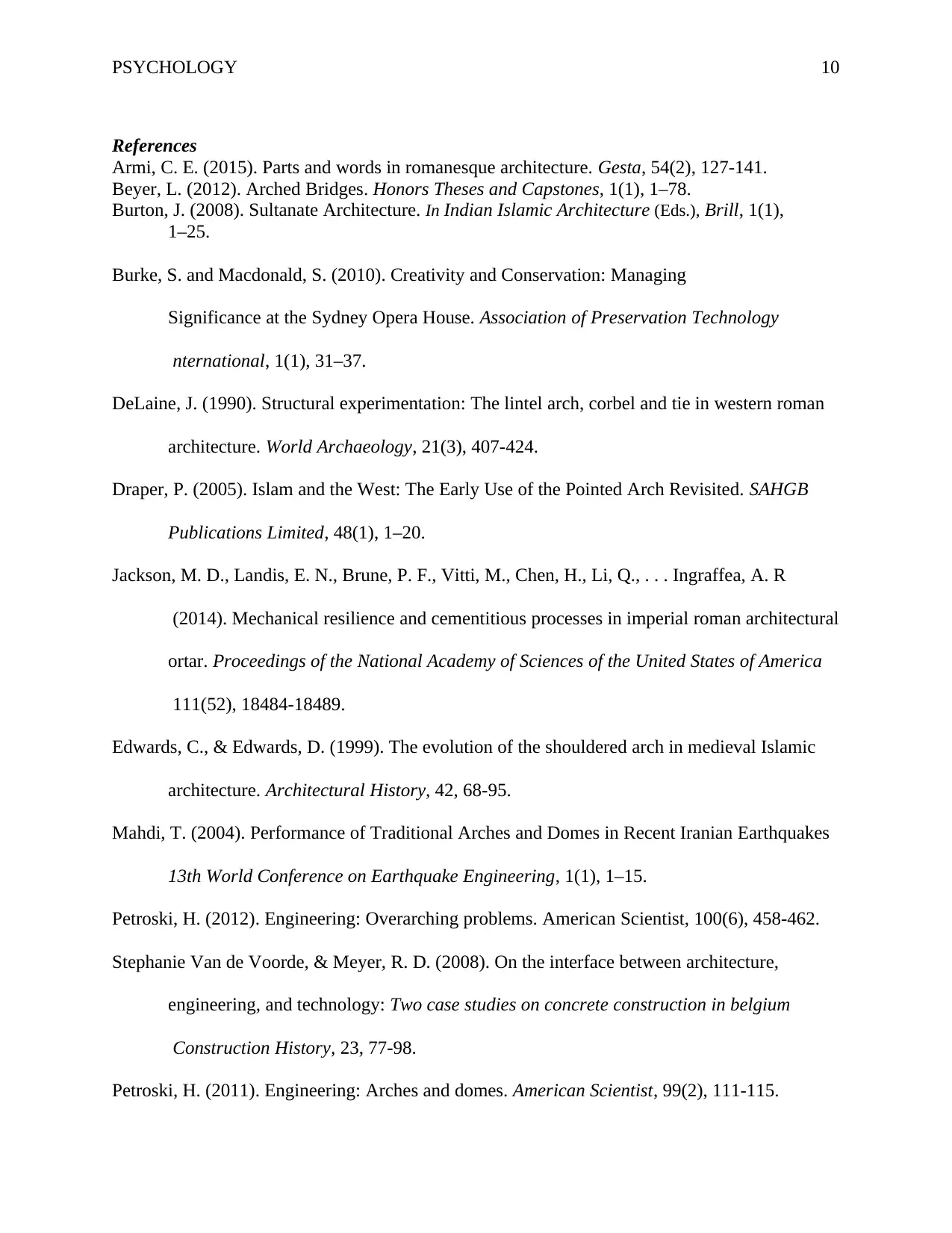
PSYCHOLOGY 10
References
Armi, C. E. (2015). Parts and words in romanesque architecture. Gesta, 54(2), 127-141.
Beyer, L. (2012). Arched Bridges. Honors Theses and Capstones, 1(1), 1–78.
Burton, J. (2008). Sultanate Architecture. In Indian Islamic Architecture (Eds.), Brill, 1(1),
1–25.
Burke, S. and Macdonald, S. (2010). Creativity and Conservation: Managing
Significance at the Sydney Opera House. Association of Preservation Technology
nternational, 1(1), 31–37.
DeLaine, J. (1990). Structural experimentation: The lintel arch, corbel and tie in western roman
architecture. World Archaeology, 21(3), 407-424.
Draper, P. (2005). Islam and the West: The Early Use of the Pointed Arch Revisited. SAHGB
Publications Limited, 48(1), 1–20.
Jackson, M. D., Landis, E. N., Brune, P. F., Vitti, M., Chen, H., Li, Q., . . . Ingraffea, A. R
(2014). Mechanical resilience and cementitious processes in imperial roman architectural
ortar. Proceedings of the National Academy of Sciences of the United States of America
111(52), 18484-18489.
Edwards, C., & Edwards, D. (1999). The evolution of the shouldered arch in medieval Islamic
architecture. Architectural History, 42, 68-95.
Mahdi, T. (2004). Performance of Traditional Arches and Domes in Recent Iranian Earthquakes
13th World Conference on Earthquake Engineering, 1(1), 1–15.
Petroski, H. (2012). Engineering: Overarching problems. American Scientist, 100(6), 458-462.
Stephanie Van de Voorde, & Meyer, R. D. (2008). On the interface between architecture,
engineering, and technology: Two case studies on concrete construction in belgium
Construction History, 23, 77-98.
Petroski, H. (2011). Engineering: Arches and domes. American Scientist, 99(2), 111-115.
References
Armi, C. E. (2015). Parts and words in romanesque architecture. Gesta, 54(2), 127-141.
Beyer, L. (2012). Arched Bridges. Honors Theses and Capstones, 1(1), 1–78.
Burton, J. (2008). Sultanate Architecture. In Indian Islamic Architecture (Eds.), Brill, 1(1),
1–25.
Burke, S. and Macdonald, S. (2010). Creativity and Conservation: Managing
Significance at the Sydney Opera House. Association of Preservation Technology
nternational, 1(1), 31–37.
DeLaine, J. (1990). Structural experimentation: The lintel arch, corbel and tie in western roman
architecture. World Archaeology, 21(3), 407-424.
Draper, P. (2005). Islam and the West: The Early Use of the Pointed Arch Revisited. SAHGB
Publications Limited, 48(1), 1–20.
Jackson, M. D., Landis, E. N., Brune, P. F., Vitti, M., Chen, H., Li, Q., . . . Ingraffea, A. R
(2014). Mechanical resilience and cementitious processes in imperial roman architectural
ortar. Proceedings of the National Academy of Sciences of the United States of America
111(52), 18484-18489.
Edwards, C., & Edwards, D. (1999). The evolution of the shouldered arch in medieval Islamic
architecture. Architectural History, 42, 68-95.
Mahdi, T. (2004). Performance of Traditional Arches and Domes in Recent Iranian Earthquakes
13th World Conference on Earthquake Engineering, 1(1), 1–15.
Petroski, H. (2012). Engineering: Overarching problems. American Scientist, 100(6), 458-462.
Stephanie Van de Voorde, & Meyer, R. D. (2008). On the interface between architecture,
engineering, and technology: Two case studies on concrete construction in belgium
Construction History, 23, 77-98.
Petroski, H. (2011). Engineering: Arches and domes. American Scientist, 99(2), 111-115.
Secure Best Marks with AI Grader
Need help grading? Try our AI Grader for instant feedback on your assignments.
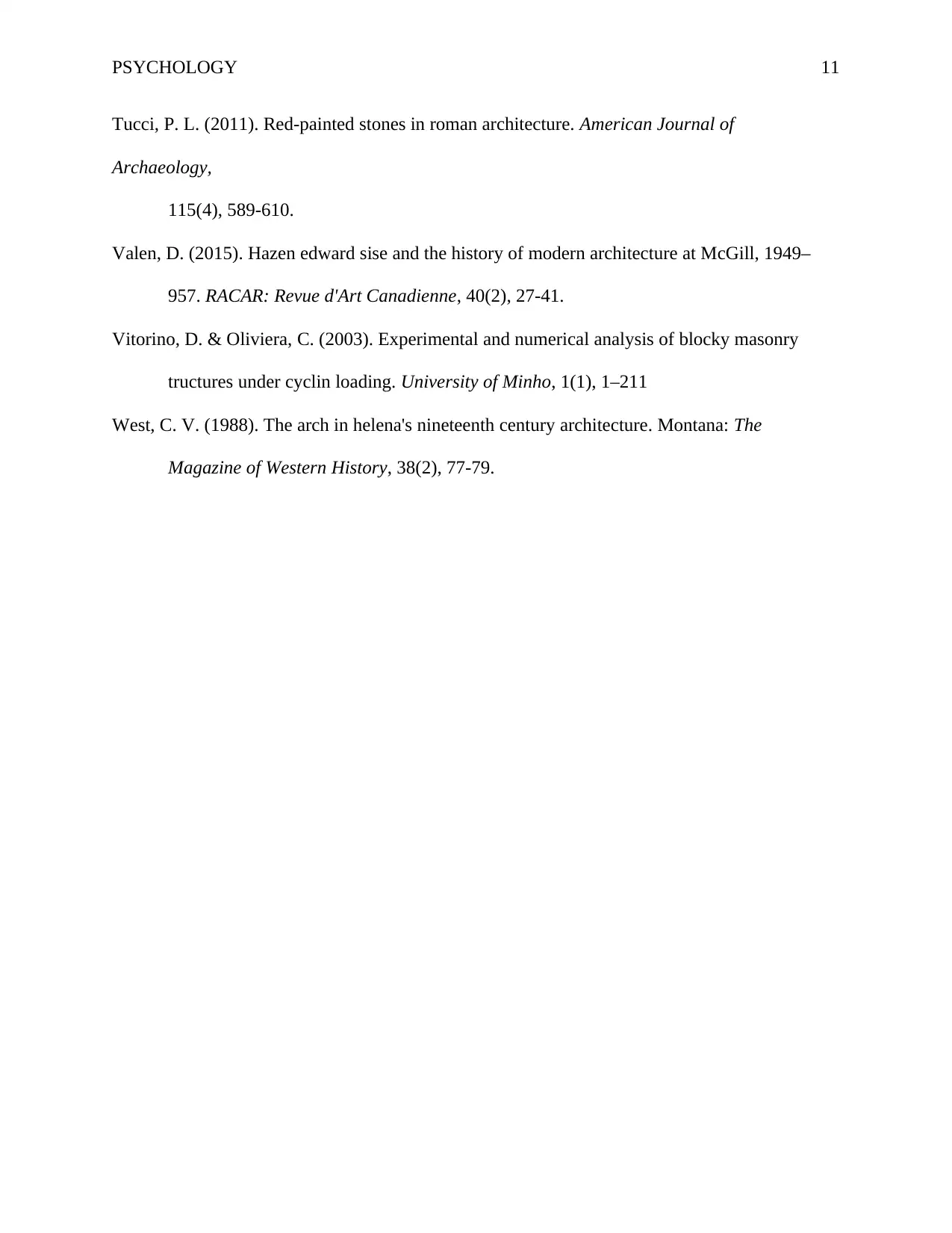
PSYCHOLOGY 11
Tucci, P. L. (2011). Red-painted stones in roman architecture. American Journal of
Archaeology,
115(4), 589-610.
Valen, D. (2015). Hazen edward sise and the history of modern architecture at McGill, 1949–
957. RACAR: Revue d'Art Canadienne, 40(2), 27-41.
Vitorino, D. & Oliviera, C. (2003). Experimental and numerical analysis of blocky masonry
tructures under cyclin loading. University of Minho, 1(1), 1–211
West, C. V. (1988). The arch in helena's nineteenth century architecture. Montana: The
Magazine of Western History, 38(2), 77-79.
Tucci, P. L. (2011). Red-painted stones in roman architecture. American Journal of
Archaeology,
115(4), 589-610.
Valen, D. (2015). Hazen edward sise and the history of modern architecture at McGill, 1949–
957. RACAR: Revue d'Art Canadienne, 40(2), 27-41.
Vitorino, D. & Oliviera, C. (2003). Experimental and numerical analysis of blocky masonry
tructures under cyclin loading. University of Minho, 1(1), 1–211
West, C. V. (1988). The arch in helena's nineteenth century architecture. Montana: The
Magazine of Western History, 38(2), 77-79.

PSYCHOLOGY 12
1 out of 12
Your All-in-One AI-Powered Toolkit for Academic Success.
+13062052269
info@desklib.com
Available 24*7 on WhatsApp / Email
![[object Object]](/_next/static/media/star-bottom.7253800d.svg)
Unlock your academic potential
© 2024 | Zucol Services PVT LTD | All rights reserved.